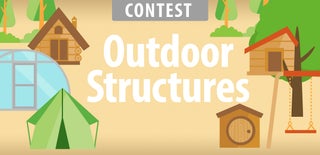Introduction: Bird and Bug Boxes
I was asked to help with a friends beaver scouts group who wanted to make some bird and bug boxes. The plan was to use recycled materials and pre-cut things to size. The beavers would then assemble them and find the materials to fill the bug houses.
The bird boxes were made from off-cuts of 4" waste pipe 8" long, combined with some 6"x1" pallet wood.
The bug boxes where made from a range of wood scraps and pallet wood.
I apologies for the lack of photos for every stage, but managing kids and a camera was not easy.
This photo is of my son who was very pleased with his test run build.
Step 1: Bird Box Components
There are three 6"x1" wood components for the bird box. The back was roughly 10" long, the roof 5.5" and the base 5"
The pipe had a 1" entrance hole drilled in it with a hole saw and a smaller 1/4" one drill just below for the dowel perch. There is also a small pilot hole drilled trough the back via the entrance hole to allow it to be secured to the back.
The entrance hole size depends on the species you hope to attract:
25 mm for blue, coal and marsh tits
28 mm for great tits, tree sparrows and pied flycatchers
32 mm for house sparrows and nuthatches
45 mm for starlings
Step 2: Bird Box Assembly
I produced a simple plan to show how to assemble the box.
1) nail the base to the back with three nails through the back
2) screw the tube to the back above the base (a small gap here is not a problem as it allows for drainage and ventilation)
3) the roof is then nailed above the tube
4) finally the perch is pushed into the hole
5) any sharp edges are filled down on the entrance hole
A VARIATION: inside of a entrance hole you cut a opening in the front, this is preferred by Robins and Wrens
NOTE: a perch is not always necessary and if you chose not to put one in, just rough the front of the tube up to allow the birds to grip
Step 3: Bug Box/Hotel
I made several types for bug box kits to be assembled and filled.
The triangular one was made out of 4"x1" pallet wood with other pallet wood for the back. The cross brace was made from a piece of 2"x4" which had 1/4" holes drilled in it. Again the components were simply nailed together.
The tall bug hotels where made from more 6"x1" pallet wood and stand around 14"-16" high and are simply nailed together. Some had pitched roofs and some sloped.
The box with slots in the front is a butterfly house, again it is made from 6"x1" pallet wood and is a simple rectangle with sloped roof. The front slots were cut in with a router but a jigsaw would work just as well. The box has a length of bark inside for the butterfly to perch on. Once again it was just nailed together.
The final little branch box is for ladybirds and is made form a 6" section of branch with a 1" hole bored 2/3 of the way down the middle and several 1/4" holes bored from the sides into the middle. Finally a small roof and base are nailed on.
Step 4: The Results
This is the result of two groups of beavers, some having never used tools before and they all went home happy and satisfied with there work.

Runner Up in the
DIY Summer Camp Challenge

Participated in the
Outside Contest 2016

Participated in the
Outdoor Structures Contest













